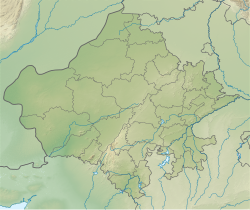| Battle of Singoli | |||||||||
|---|---|---|---|---|---|---|---|---|---|
| Part of List of Mewar (Sisodiya)–Delhi conflicts | |||||||||
| |||||||||
| Belligerents | |||||||||
| Commanders and leaders | |||||||||
| Hammir Singh | Disputed | ||||||||
Location within South Asia | |||||||||
The Battle of Singoli was a military engagement on land, fought between the rebelling forces of Mewar, led by Hammir Singh, and the Delhite forces at Singoli, in present-day Madhya Pradesh, India. [1]
Hammir Singh had gained control of Mewar by evicting Maldev's son Jaiza, the Chauhan vassal of the Delhi Sultanate. Jaiza fled to the Delhi court of Muhammad bin Tughluq, prompting Tughlaq himself to march towards Mewar with his strong army. In the ensuing battle, the Tughlaq army was defeated and Muhammad bin Tughlaq was taken prisoner. He was kept prisoner in Chittorgarh for three months and released after the Sultanate ceded Ajmer, Ranthambor, Nagaur and Sopor; and paid 50 lakhs rupees and 100 elephants as ransom to Hammir Singh. [2] The above narrative is according to Rajput chronicles. According to Rima Hooja and Majumdar, the defeat and the imprisonment of the Sultan cannot be regarded as true without corroborative evidence. However the conflict where Sisodias defeated Delhi Sultanate at Singoli altogether cannot be regarded baseless, a 1438 Jain temple inscription attests that Rana Hammir Singh's forces defeated a Muslim army; this Sultanate army could have been led by some generals, and not Muhammad bin Tughlaq himself. [1] [2]

